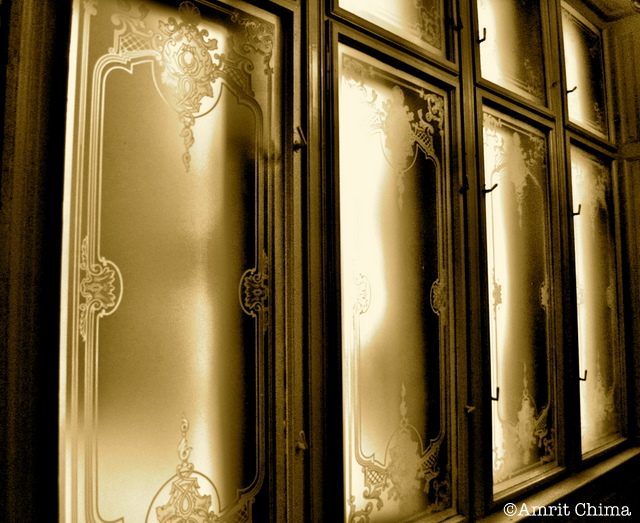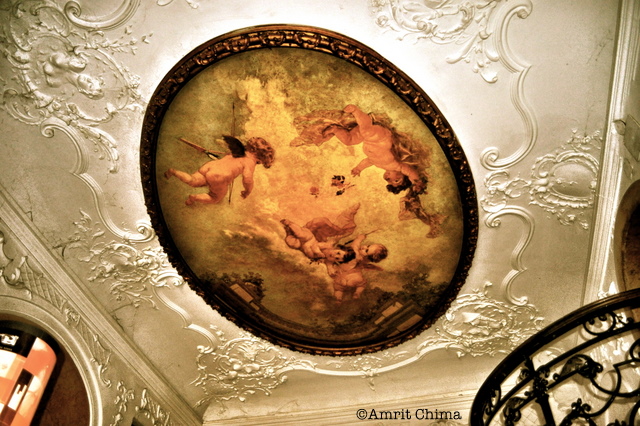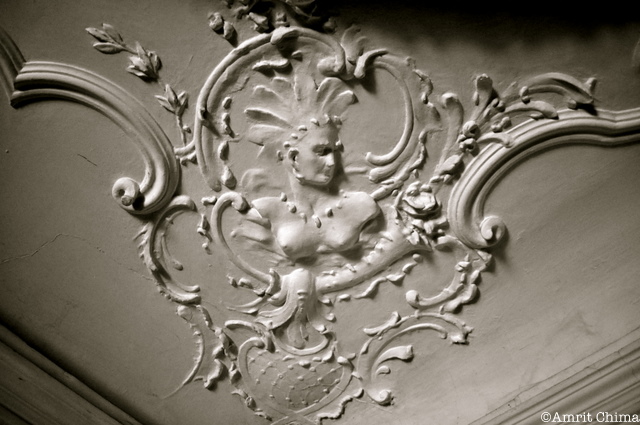 Art-Nouveau-style frosted glass windows inside Mai Manó Ház, a center for Hungarian photography
Art-Nouveau-style frosted glass windows inside Mai Manó Ház, a center for Hungarian photography
Sauntering lazily through Budapest’s city center on the first Saturday of summer, I joined a group of inquisitive expatriates, all of whom, like me, were hoping to glean some deeper understanding of the city we now call our home. What we discovered was a sliver of history, a luminous layer beneath the heartache of communism, beneath the horror of Nazi rule, and beneath two World Wars. We glimpsed a time over a hundred years ago when idealism was pursued in pure, unfettered earnest by means of a globally budding art form fittingly called Art Nouveau.
The style, known as Szecesszió in Hungarian, was first characterized in an 1894 issue of Berlin’s arts and literary magazine, Pan, as “sudden violent curves generated by the crack of a whip.” Think the undulating façade of Antoni Gaudi’s Casa Batlló, or the burlesque image of that iconic Moulin Rouge poster. Think a combination of curvilinear shapes and right angles, birds, flowers, insects and femme fatales. Art Nouveau, which took shape from the 1880s to just prior to World War I, is not to be confused with the streamlined, geometric shapes of Art Deco (as in New York City’s Chrysler Building), which flourished in the roaring twenties along with post war industrialism.
Globally, Art Nouveau’s expression was wide-ranged, the movement bohemian. Artists of the time redefined the very meaning and purpose of art, often convening in coffee shops to explore the endless possibilities of new thought and voice. The wealthy supported and indulged these men and women, allowing for an eruption of varying ideas that flowed lava-like into every crevice and corner of the globe.
Ödön Lechner, an Art Nouveau pioneer in Hungary during the Austro-Hungarian Empire, was initially influenced by both Indian and Syrian designs, as illustrated by the implementation of his ideas to Budapest’s Museum of Applied Arts.
 Magyar Iparművészeti Múzeum (Museum of Applied Arts), designed by Ödön Lechner and Gyula Pártos and built between 1893 and 1896
Magyar Iparművészeti Múzeum (Museum of Applied Arts), designed by Ödön Lechner and Gyula Pártos and built between 1893 and 1896
Like so much that evolves in Hungary, Art Nouveau solidified into its current expression because the country, historically linked to a various line of ruling nations, has in turn been seduced by each of them. But artists of this country also possess an abiding loyalty to the traditions rooted in their own culture, a source of zealous pride among Hungarians. The swelling domes of the Far East and the elegant, coy curves of Western European Baroque seamlessly melt into the multihued, flowering spirals of Hungarian folk art.
The global movement sought to break ties with all things classical in form, though some works paradoxically—and skillfully—combined Art Nouveau with Renaissance Revival, which is emphatically classic. The movement aspired to transcend the view that art should be elevated, set on a pedestal above the mundane. It therefore incorporated beauty into daily, practical life—in furniture, tapestries, paintings, glassware, jewelry, metalwork, textiles and more—thereby heightening the everyday quality of existence. Artists were duty bound by a self-imposed code of ethics to transform the most utilitarian, humdrum articles and gadgets into objects of splendor. But the lasting mark of it in Budapest can best be seen in the architecture.
 Façade of the Mai Manó Ház, built from 1893 to 1894. The building is home to the Magyar Fotográfusok Háza (House of Hungarian Photographers).
Façade of the Mai Manó Ház, built from 1893 to 1894. The building is home to the Magyar Fotográfusok Háza (House of Hungarian Photographers).
 Detail on the façade of Mai Manó Ház
Detail on the façade of Mai Manó Ház
 Ceiling of the Mai Manó Ház foyer
Ceiling of the Mai Manó Ház foyer
 Detail of the Mai Manó Ház foyer ceiling
Detail of the Mai Manó Ház foyer ceiling
 Façade of Alexandra Bookstore on Andrássy Út. The building was erected in 1911.
Façade of Alexandra Bookstore on Andrássy Út. The building was erected in 1911.
 Ceiling of Alexandra Bookstore’s tea and coffee shop. It is a combination of both Art Nouveau and the Renaissances Revival style from which many artists of the time strove to distance themselves.
Ceiling of Alexandra Bookstore’s tea and coffee shop. It is a combination of both Art Nouveau and the Renaissances Revival style from which many artists of the time strove to distance themselves.
 Façade of Ernst Múzeum, built in 1912
Façade of Ernst Múzeum, built in 1912
For the wandering art enthusiast, the most elusive examples of Art Nouveau are the designs in foyers of common apartment tenements, as seen below. I can only imagine the treasures I wasn’t able to see, the concealed delights, flints meant to spark a nation and a world that had festered too long in the old. It was time for the new.
 Peeking through the bars and glass of an apartment complex entrance, known casually as the Napoleon building. The tenement was once dedicated to Napoleon III. The stained-glass art on the windows are perfect examples of Art Nouveau.
Peeking through the bars and glass of an apartment complex entrance, known casually as the Napoleon building. The tenement was once dedicated to Napoleon III. The stained-glass art on the windows are perfect examples of Art Nouveau.
 Façade of the Napoleon building
Façade of the Napoleon building
The walk left me humbled. Art was so valued at the turn of the twentieth century, artists so encouraged, the resulting beauty—either showcased publically or still lingering in the common areas of private residences—is impressive. Today, it’s difficult not to scoff at all those dime-a-dozens saturating the entertainment industry, or at the fact that literary novel sales are smoked by those bestsellers recounting tales of how people met their dogs or the best way to eradicate cellulite. What I saw in Budapest makes me feel nostalgic for a time before my time, for an era when art was an internal struggle and a fierce desire to unleash a statement.






